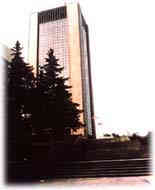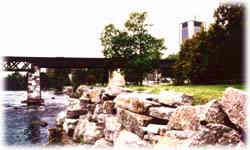Campus in Transition: Managing a Cultural Heritage
 |
 |

 | Stairs north of the Tory Building, 1992. |
| Library: Special Collections and Archives.
|
Buffeted by political and economic effects, Carleton, in the early 1990's, has entered into a state
of developmental pause. This is an opportune moment to reflect on the campus design concept and past
construction achievements, and to propose a renewed planning philosophy for future development of this site.
It is an interesting and appropriate exercise to visually contrast that which is
architecturally harmonious with that which is not; and, from this comparison, to extrapolate a
blueprint of opportunity.
The thrust of Carleton's formative campus plan was recognition
of its rugged and varied topography, and the stated desire to discipline the site with strong architectural
geometries, the features of which were to be low-rise horizontal buildings grouped so as to ceate courtyards.
The central quadrangle, atop the high point of land, was seen as a unifying planning element.
The acropolis-like Tory Building, Paterson Hall and MacOdrum Library ensemble was a result - a
forthright symbol of purpose, pride of place and institutional self-confidence.
 |
 |

 | Parking lot south of Architecture Building, 1992. |
| Library: Special Collections and Archives.
|
 |  |

 | Rideau River shoreline near Alumni Park, 1970. |
| Carleton University Library: Special Collections and Archives. |



